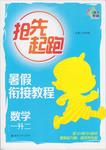题目内容
The socks are so ______ that they can't be mended any more.
A.used up B.worn out
C.tired out D.broken out
B
use up“用完,耗尽”;tire out“使十分疲劳”;break out“(战争、火灾等)突然发生,爆发”;wear out“穿破,用坏;克服;消磨;疲劳”。句意:这些袜子穿坏了,不能再补了。根据句意知应选B项。

 数学奥赛暑假天天练南京大学出版社系列答案
数学奥赛暑假天天练南京大学出版社系列答案 南大教辅抢先起跑暑假衔接教程南京大学出版社系列答案
南大教辅抢先起跑暑假衔接教程南京大学出版社系列答案One of my wonderful memories is about a Christmas gift. Unlike other gifts,it came without wrap(包装).
On September 11 th , 1 958,Mum gave birth to Richard.After she brought him home from hospital,she put him in my lap,saying, “I promised you a gift, and here it is.” What an honor! I turned four a month earlier and none of my friends had such a baby doll of their own.I played with it day and night. I sang to it, I told it stories.I told it over and over how much I loved it!
One morning, however,I found its bed empty. My doll was gone! I cried for it.Mum wept and told me that the poor little thing had been sent to a hospital.It had a fever. For several days,I heard Mum and Dad whispering such words as “hopeless”,“pitiful",and “dying”, which sounded Ominous.
Christmas was coming, “Don’t expect any presents this year,” Dad said, pointing at the socks I hung in the living room. “If your baby brother lives, that’ll be Christmas enough.” As he spoke,his eyes filled with tears. I’d never seen him cry before.
The phone rang early on Christmas morning.Dad jumped out of bed to answer it.From my bedroom I heard him say, “What? He’s all right?” He hung up and shouted upstairs. “The hospital said we can bring Richard home!” “Thank God!” I heard Mum cry.
From the window upstairs,I watched my parents rush out to the car.I had never seen them so happy. And I was also full of joy. What a wonderful day! My baby doll would be home. I ran downstairs. My socks still hung there flat.But I knew they were not empty: they were filled with love !
【小题1】What happened to the author on September 11th,1958?
| A.He got a baby brother. | B.He got a Christmas gift. |
| C.He became four years old. | D.He received a doll. |
| A.Impossible. | B.Boring. | C.Difficult. | D.Fearful. |
| A.Excitement. | B.Happiness. | C.Sadness. | D.Disappointment. |
It was Sunday. I had one last patient to see. I approached her room in a hurry and stood at the doorway. She was an old woman, sitting at the edge of the bed, struggling to put socks on her swollen(肿胀的)feet. I entered, spoke quickly to the nurse and examined her chart. She was getting better.
I looked down at her. She asked if I could help put on her socks. Instead, I said something like this:“ How are you feeling? Your sugars and blood pressure were high but they’re better today. The nurse mentioned you were anxious to see your son who’s visiting you today. I bet you really look forward to seeing him.”
She stopped me with a serious voice, as if she was giving an order. “ Sit down,Doctor.This is my story,not your story. ”
I was surprised and embarrassed. I sat down. I helped her with the socks. She began to tell me that her only son lived around the corner from her, but she had not seen him in five years. She believed that her health problems really had something to do with it. After hearing her story and putting on her socks, I asked if there was anything else I could do for her. She shook her head and smiled. All she wanted me to do was to listen.
Later on, I often thought of what that woman taught me. Everyone has a story and each story is different. Some have a beginning, middle and end. Others wander without a clear conclusion. Yet all those things do not really matter. What matters to the storyteller is that the story is heard—without interruption or judgment.
【小题1】 The writer went to visit the older woman to .
| A.1isten to her story | B.tell her good news |
| C.help her put on her socks | D.see if she was getting better |
| A.She ate too much sugar. |
| B.She had high blood pressure. |
| C.She had too many visits. |
| D.She liked telling others stories. |
| A.not having seen her son for long | B.having no one to look after her |
| C.serious voice when giving orders | D.struggling to put socks on her feet |
| A.Everyone should learn to listen to others. |
| B.Children had better stay with their parents. |
| C.We all have a story and each one is different. |
| D.Older women are good at telling their stories. |